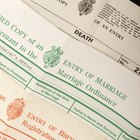
Unlike death notices, which are typically written in the straightforward style of a news item, obituaries usually include biographical details and anecdotes that show why the deceased person was special to those who knew him. If you are asked to write a biographical obituary, contact the funeral director for the basic facts, then interview the person's family members, friends and colleagues for the stories that will honor his memory.
Organizing the Obituary
Give the deceased person's full name, including a nickname, if it was commonly used. Include the person's city and state of residence, the date of death and his age. Check with the family for permission to include the cause of death.
List the deceased's education and occupation, including degrees earned and awards. If the person had special or unusual hobbies, describe them. They will bring out her personality, which is one of the goals of a biographical obituary.
List survivors. The standard order is: spouse, children, grandchildren, great-grandchildren, parents, grandparents, siblings, other relatives, special friends and pets. If space is limited, ask the family which names to leave out. The obituary also may include names of family members who preceded the person in death.
Give the date and time for the visitation and funeral service. Include the street address and telephone number of the funeral home or place of worship, so mourners can get additional information. Some obituaries also list the names of pallbearers and clergy who will conduct the service.
Include memorial information, with the names and addresses of designated organizations. Thank hospital and hospice staff who may have been helpful to the deceased and the family.
Related Articles

How to Find Out the Birth & Death Dates ...

How Do I Find Out the Tax ID Number for ...

How Do You Address Wedding Invitations ...

How to Find Out When Someone Died

How to Apply for a Long-Form Birth ...

What Is a First-Degree Relative?

How to Get a Marriage Certificate Online

How to Legally Change a Child's Last ...

Obituary Wording Help

How to Apply for a Birth Certificate

Help With Funeral Payments for ...

How to Write a Sample Wedding Program

How to Obtain a Chinese Birth ...

How to Get Certified to Marry Couples

How to Hire a Minister for a Funeral

How to Get Married By the Justice of ...

Minister Checklist For a Wedding

How to Write a Sympathy Thank You to ...

Calories in One Slice Provolone Cheese

How to File a Marriage License
References
Tips
- If your biographical obituary is a feature story, running in addition to a full death notice, you will have more space for anecdotal stories. Eliminate all but the most essential factual details.
- Refer to the deceased as an individual in his own right. Often family members talk about "Dad" or "Grandpa" in an obituary, but that focuses on the survivors, rather than the person who has died.
- Use clear, simple language. Flowery descriptions or outdated expressions can make an obituary sound stilted.
- Ask the family for a photo to be published with the obituary.
Warnings
- Do not write "in lieu of flowers." Instead, simply state where to send appropriate memorials.
- Avoid euphemisms, such as "dearly departed," "succumbed" and "expired."
- Leave out the person's date of birth and, in the case of a married woman, her maiden name. This kind of information, commonly included in the past, can now be used for identity theft.
- Avoid including the deceased's street address. It alerts criminals to a home that will likely be unattended during the hours of the visitation, funeral service and burial.
Writer Bio
Lauryn Macy Roberts is a Midwesterner who began writing professionally in 2009 when she coauthored a grant-writing book. Since then, her work has appeared in various online publications. Roberts has taught English and composition for several years. She earned a Bachelor of Science in education from the University of Wisconsin and is completing a Master of Arts in professional writing at Mount Mary College.
Photo Credits
peace 1 image by FotoWorx from Fotolia.com